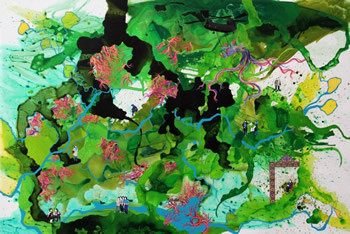The Ying Quartet was the final offering on the 2001-2002 season for Duke’s Chamber Arts Society. This admirable series, which has been selling out for over a decade, attracts such support and loyalty because of its world-class mix of well-known ensembles as well as up-and-coming entrants to the first ranks.
Now in their tenth year, the Ying Quartet can officially be moved from new to established. These four Chicago-born siblings have made a name for themselves with innovative projects and commissions. They began their career with an NEA grant to bring chamber music to rural America and have continued to perform in many non-traditional settings, from hospital and prisons, in addition to the usual classical venues around the US and the world.
Although they all now are moving past their mid-thirties, they still bring a youthful fire to their playing, tempered with an overlay of focused concentration. Their sound is leaner than quartets of the two preceding generations and they emphasize more of the subtleties over bigger, showier moments.
These characteristics were evident from the first few pages of Mendelssohn’s Quartet No. 3, Op. 44, No. 1. They quickly established a smooth, extremely mellow sound, maintained throughout the concert. They gave the sprightly phrases energy and intensity while playing within a delicate confine. The little surges in dynamics and the slight silences between sections indicated the foursome’s extreme attention to detail.
They made the sweet second movement sound quite homey and firelit. First violinist Timothy Ying allowed his tone to become almost too tentative, attempting to maintain a hushed atmosphere, but left no doubt of his skills in the beautifully sinuous third movement, his cadenza most expressive. This movement is in a class by itself, with the Bach-like blending of the two violins (sister Janet on the second), accompanied by the languid pizzicatos of the viola and cello.
For the presto fourth movement, the four leaned into their bowing with a springy tempo, the little waves of intensity surfacing delightfully. Cellist David was especially fun to watch (as are all good cellists) as he exhibited obvious delight in digging into his instrument’s intense commentaries.
Violist Phillip introduced the second work, Eagle at Sunrise by Augusta Read Thomas. This piece is the most recently completed of the commissions by the Ying Quartet (with support by the Institute for American Music) to produce distinctively American quartet repertoire. Phillip explained that, while Thomas normally did not conjure images for her music, for this work she did work with the idea of an eagle flying in the early morning, seeking to suggest its unwavering majesty. Since the piece was completed on September 14, 2001, there are obvious connections with America’s symbolic bird and the terrorist attacks.
This seven-minute piece begins with a cello solo, somber and solitary. The first violin takes up the theme before being joined by the rest of the instruments. The music projects a sort of hovering with sudden swoops, underlined the while with an anticipatory tension. A somewhat warmer middle section conveys a short restfulness before launching into a fluttering, followed by harsh chords, as though in battle. The piece ends on a calmer note but the tension has never really been released. For this solemn, slightly disturbing work, the Yings’ playing was unemotional yet deeply felt, imbuing the bleakness with a quiet strength.
After intermission, the Yings were joined by pianist Wu Han for Schumann’s popular Quintet in E-flat, Op. 44. Han has made a name in chamber playing in all the major venues and festivals of the US and many other countries. Her evident energy and relish for the piece spurred the others on to a lush, romantic approach, appropriate to the composer. Yet they did not overdo the turbulence and intensity, giving the whole a light touch. This was especially true for the piano part, which can often dominate the rest of the playing when the player is determined to show off. Han beautifully integrated the piano phrases into the string playing, bringing forth certain key measures but never overpowering the musical moment.
The vaunting theme of the first movement was rhythmically snappy as was the bouncy fourth. The funeral-march second movement was suitable serious but moved along, nicely contrasted with the hopeful second theme and the stormy third section. The many scale runs of the third movement were gently fleet and airy.
Some may have found an overall diminutiveness to the Yings’ playing, especially those used to a more outsized, robust playing of the Mendelssohn and Schumann. However, it was instructive to hear these works interpreted with the smaller moments in mind, allowing the hearer to find new depths in these established works.











